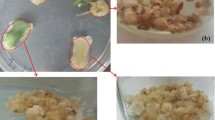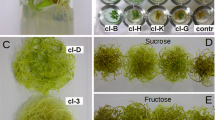Abstract
Momordica charantia is an important vegetable crop and is also used in traditional medicine. The production of secondary metabolites from hairy root cultures of Indian M. charantia (IMC) and Korean M. charantia (KMC) along with their biological activities (antioxidant and antimicrobial activities) were compared. The explants (leaves, cotyledons, hypocotyls, roots, and nodes) from in vitro seedlings were inoculated with Agrobacterium-rhizogenes strains (KCTC 2703 and KCTC 2704) for the induction of hairy roots. Established transgenic clones of hairy roots were confirmed by polymerase chain reaction (PCR), reverse transcription-PCR and sequencing using rolC specific primers. Hairy roots cultured in MS liquid medium supplemented with 3 % sucrose showed the highest accumulation of biomass [95.11 g/l fresh mass (FM) and 10.61 g/l dry mass (DM) in IMC and 93.58 g/l FM and 10.12 g/l DM in KMC]. The flask cultures of IMC and KMC increased in their biomass up to 9.6- and 9.4-fold after 20 days of culture. MS basal liquid medium supplemented with 3 % sucrose was superior for the growth of hairy roots compared with other culture media evaluated (B5, NN and N6), for biomass and phenolic compounds production. A total of 27 phenolic compounds were identified by ultra-performance liquid chromatography analysis. The flavonoids (catechin, myricetin and quercetin) and the phenolic acids (gallic acid, chlorogenic acid, gentisic acid and salicylic acid) levels were highly increased in hairy roots than in untransformed control roots. The metabolites such as ferulic acid, rutin, naringenin and naringin levels were decreased significantly in the hairy roots compared with untransformed roots. Due to these metabolic variations, the antioxidant and antimicrobial activities were increased with hairy roots compare to untransformed roots. In terms of biomass, phenolic compounds and biological activities the hairy roots of IMC were superior to KMC was observed. This is the first report describing the production of phenolic compounds and biological activities from hairy root cultures of M. charantia.




Similar content being viewed by others
Abbreviations
- B5:
-
Gamborg’s B5 medium (Gamborg et al. 1968)
- DPPH:
-
1,1-Diphenyl-2-picrylhydrazyl
- DM:
-
Dry mass
- FM:
-
Fresh mass
- IMC:
-
Indian Momordica charantia
- KMC:
-
Korean Momordica charantia
- MS:
-
Murashige and Skoog medium (Murashige and Skoog 1962)
- NN:
-
Nitsch and Nitsch medium (Nitsch and Nitsch 1969)
- N6:
-
Chu’s medium (Chu 1978)
- PCR:
-
Polymerase chain reaction
- RT PCR:
-
Reverse transcription polymerase chain reaction
- UPLC:
-
Ultra performance liquid chromatography
References
Betsui F, Tanaka-Nishikawa N, Shimmomura K (2004) Anthocyanin production in adventitious root cultures of Raphanus sativus L. cv. Peking Koushin. Plant Biotechnol 21:387–391
Blois MS (1958) Antioxidant determinations by the use of a stable free radical. Nature 181:1199–1200
Bourinbaiar AS, Lee-Huang S (1996) The activity of plant derived antiretroviral proteins MAP30 and GAP31 against herpes simplex virus in vitro. Biochem Biophys Res Commun 219:923–929
Bulgakov VP (2008) Functions of rol genes in plant secondary metabolism. Biotech Adv 26:318–324
Chu CC (1978) The N6 medium and its applications to anther culture of cereal crops. In: Proceedings of symposium plant tissue culture. Science Press, Beijing, pp 43–50
Danphitsanuparn P, Boonsnongcheep P, Boriboonkaset T, Chintapakorn Y, Prathanturarug S (2012) Effects of Agrobacterium rhizogenes strains and other parameters on production of isoflavonoids in hairy roots of Pueraria candollei Grah. ex Benth. var. candollei. Plant Cell Tissue Organ Cult 111:315–322
Gamborg OL, Miller RA, Ojima K (1968) Nutrient requirements of suspension cultures of soybean root cells. Exp Cell Res 50:151–158
Giri A, Narasu ML (2000) Transgenic hairy roots: recent trends and applications. Biotechnol Adv 18:1–22
Gordon MH (1990) The mechanism of the antioxidant action in vitro. In: Hudson BJF (ed) Food antioxidants. Elsevier, London, pp 1–18
Grover JK, Yadav SP (2004) Pharmacological actions and potential uses of Momordica charantia: a review. J Ethnopharmacol 93:123–132
Hamill JD, Parr AJ, Robins RJ, Rhodes MJC, Walton N (1987) New routes to secondary products. Bio/Tech 5:800–804
Horax R, Hettiarachchy N, Islam S (2005) Total phenolic contents and phenolic acid constituents in 4 varieties of bitter melons (Momordica charantia) and antioxidant activities of their extracts. J Food Sci 70:C275–C280
Horax R, Hettiarachchy N, Chen P (2010) Extraction, quantification, and antioxidant activities of phenolics from pericarp and seeds of bitter melons (Momordica charantia) harvested at three maturity stages (immature, mature, and ripe). J Agric Food Chem 58:4428–4433
Kähkönen MP, Hopia AI, Vuorela HJ, Rauha JP, Pihlaja K, Kujala TS, Heinonen M (1999) Antioxidant activity of plant extracts containing phenolic compounds. J Agric Food Chem 47:3954–3962
Katerere DR, Eloff JN (2005) Antibacterial and antioxidant activity of Sutherlandia frutescens (Fabaceae), a reputed Anti-HIV/AIDS phytomedicine. Phytother Res 19:779–781
Kim Y, Wyslouzil BE, Weathers PJ (2002) Secondary metabolism of hairy root cultures in bioreactors. In Vitro Cell Dev Biol Plant 38:1–10
Kim YK, Li X, Xu H, Park NI, Uddin MR, Pyon JY, Park SU (2009) Production of phenolic compounds in hairy root culture of tartary buckwheat (Fagopyrum tataricum Gaertn). J Crop Sci Biotechnol 12:53–58
Lee YJ, Thiruvengadam M, Chung IM, Nagella P (2013) Polyphenol composition and antioxidant activity from the vegetable plant Artemisia absinthium L. Aust J Crop Sci 7:1921–1926
Luczkiewicz M, Kokotkiewicz A (2005) Genista tinctoria hairy root cultures for selective production of isoliquiritigenin. Z Naturforsch C 60:867–875
Murashige T, Skoog F (1962) A revised medium for rapid growth and bioassays with tobacco tissue cultures. Physiol Plant 15:473–497
Murthy HN, Dijkstra C, Paul A, White DA, Davey MR, Power JB, Hahn EJ, Paek KY (2008) Establishment of Withania somnifera hairy root cultures for the production of withanolide A. J Integr Plant Biol 50:975–981
Mwambete KD (2009) The in vitro antimicrobial activity of fruit and leaf crude extracts of Momordica charantia: a Tanzania medicinal plant. Afr Health Sci 9:34–39
Nagella P, Thiruvengadam M, Jung SJ, Murthy HN, Chung IM (2013) Establishment of Gymnema sylvestre hairy root cultures for the production of gymnemic acid. Acta Physiol Plant 35:3067–3073
NCCLS (1997) Methods for antimicrobial susceptibility testing of anaerobic bacteria, 4th edn. Approved standard, NCCLS publication number M11-A4. National Committee for Clinical Laboratory Standards, Villanova, PA
Nitsch JP, Nitsch C (1969) Haploid plants from pollen grains. Science 163:85–87
Oyaizu M (1986) Studies on products of browning reactions: antioxidative activities of browning reaction prepared from glucosamine. Jpn J Nutr 44:307–315
Park NI, Tuan PA, Li X, Kim YK, Yang TJ, Park SU (2011) An efficient protocol for genetic transformation of Platycodon grandiflorum with Agrobacterium rhizogenes. Mol Biol Rep 38:2307–2313
Piatczak E, Krolicka A, Wysokinska H (2006) Genetic transformation of Centaurium erythraea Rafn by Agrobacterium rhizogenes and the production of secoiridoids. Plant Cell Rep 25:1308–1315
Pin-Der-Duh X (1998) Antioxidant activity of burdock (Arctium lappa Linné): its scavenging effect on free radical and active oxygen. J Am Oil Chem Soc 75:455–461
Prieto P, Pineda M, Aguilar M (1999) Spectrophotometric quantitation of antioxidant capacity through the formation of a phosphomolybdenum complex: specific application to the determination of vitamin E. Anal Biochem 269:337–341
Ramachandra Rao S, Ravishankar GA (2002) Plant cell cultures: chemical factories of secondary metabolites. Biotechnol Adv 20:101–153
Raman A, Lau C (1996) Anti-diabetic properties and phytochemistry of Momordica charantia L. (Cucurbitaceae). Phytomedicine 2:349–362
Ross JA, Kasum CM (2002) Dietary flavonoids: bioavailability, metabolic effects, and safety. Annu Rev Nutr 22:19–34
Sambrook J, Russell D (2001) Molecular cloning: a laboratory manual, 3rd edn. Cold Spring Harbor Laboratory Press, New York
Singleton VL, Rossi JA (1965) Colorimetry of total phenolics with phosphomolybdic–phosphotungstic acid reagents. Am J Enol Vitic 37:144–158
Sircar D, Roychowdhury A, Mitra A (2007) Accumulation of phydroxybenzoic acid in hairy roots of Daucus carota. J Plant Physiol 164:1358–1366
Sivakumar G, Yu KW, Hahn EJ, Paek KY (2005) Optimization of organic nutrients for ginseng hairy roots production in large-scale bioreactors. Curr Sci 89:641–649
Sujatha G, Zdravković-Korać S, Ćalić DĆ, Flaminic G, Ranjitha Kumari BD (2013) High-efficiency Agrobacterium rhizogenes-mediated genetic transformation in Artemisia vulgaris: hairy root production and essential oil analysis. Ind Crops Prod 44:643–652
Thimmaraju R, Bhagyalakshmi N, Narayan MS, Ravishankar GA (2003) Kinetics of pigment release from hairy root cultures of Beta vulgaris under the influence of pH, sonication, temperature and oxygen stress. Proc Biochem 38:1069–1076
Thiruvengadam M, Rekha KT, Jayabalan N, Yang CH, Chung IM (2010) High frequency shoot regeneration from leaf explants through organogenesis of bitter melon (Momordica charantia L.). Plant Biotechnol Rep 4:321–328
Vergauwe A, Cammaert C, Vandenberghe D, Genetello C, Inzé D, Van Montagu M, Van den Eeckhout E (1996) Agrobacterium tumefaciens-mediated transformation of Artemisia annua L. and regeneration of transgenic plants. Plant Cell Rep 15:929–933
Wang S, Tang L, Guo Y, Yan F, Chen F (2001) Determination of momordicoside A in bitter melon by high-performance liquid chromatography after solid-phase extraction. Chromatographia 53:372–374
Weremczuk-Jezyna I, Grzegorczyk-Karolak I, Frydrych B, Królicka A, Wysokińska H (2013) Hairy roots of Dracocephalum moldavica: rosmarinic acid content and antioxidant potential. Acta Physiol Plant 35:2095–2103
Willet WC (2002) Balancing life-style and genomics research for disease prevention. Science 296:695–698
Wojdyło A, Oszmiański J, Czemerys R (2007) Antioxidant activity and phenolic compounds in 32 selected herbs. Food Chem 105:940–949
Acknowledgments
This work was supported by a grant from the Next-Generation BioGreen 21 Program (Plant Molecular Center No. PJ009053), Rural Development Administration, Republic of Korea.
Author information
Authors and Affiliations
Corresponding author
Rights and permissions
About this article
Cite this article
Thiruvengadam, M., Praveen, N., Maria John, K.M. et al. Establishment of Momordica charantia hairy root cultures for the production of phenolic compounds and determination of their biological activities. Plant Cell Tiss Organ Cult 118, 545–557 (2014). https://doi.org/10.1007/s11240-014-0506-4
Received:
Accepted:
Published:
Issue Date:
DOI: https://doi.org/10.1007/s11240-014-0506-4




